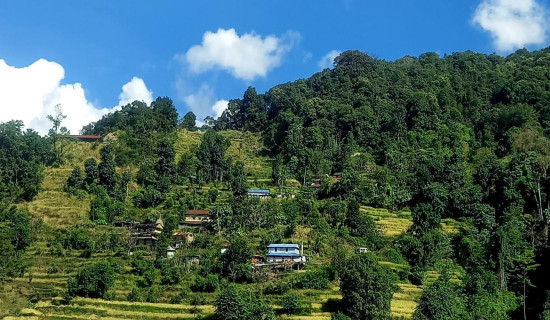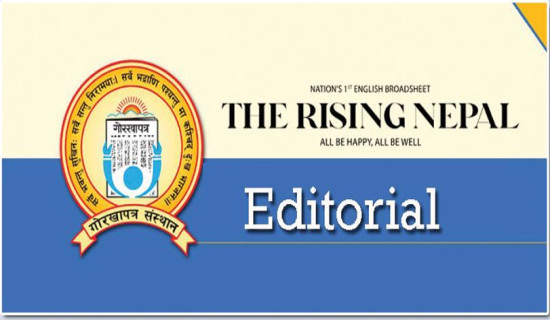- Tuesday, 11 November 2025
Painful Dashain Awaits Gen Z Martyr Families
Stop all the clocks, cut off the telephone,
Prevent the dog from barking with a juicy bone,
Silence the pianos and with muffled drum
Bring out the coffin, let the mourners come.
These opening lines from W. H. Auden's poem "Funeral Blues" reflect the profound grief and sombre mood that accompany the demise of dear ones. Now Nepal is in a similar state of despair and agony following the brutal killing of a large number of people in their prime youth in the Gen Z movement on September 8 and 9. The death toll from the protest reached 74, while hundreds have been injured. This enormous human tragedy befell the nation ahead of Dashain, the biggest festival of Nepalis. As poet Auden says, this is a moment for Nepalis to pause and be silent. The joys of Dashain have eluded parents who lost their sons and daughters.
Two weeks ago, hundreds of Gen Z youths took to the streets, demanding a lift of the ban on social networking sites and an end to the widespread corruption that has enervated the vital public institutions. As the peaceful protests turned violent, vandalism, arson and loot spread throughout the country. The buildings of Singha Durbar, the parliament and the Supreme Court were reduced to ashes. This has left the people with bad feelings. The lives lost will never be recovered, while it will take considerable time to overcome shocks and reconstruct damaged structures.
Hundreds of the injured are still undergoing treatment in different hospitals. According to Dr Badri Rijal, director at the National Trauma Centre, a total of 187 individuals injured during the Gen Z protests returned home after getting treatment from the centre, while 31 are still in the hospital. Of them, four have been admitted to the ICU. Even discharged patients visit the hospital for follow-up. It is a similar situation in major hospitals, including Civil Hospital.
Agonising stories
Every parent who lost their loved ones in the Gen Z revolt has painful stories to share. "Before going to attend the protest, my son had assured me that he would be safe as he went there in a college uniform," said Ganesh Chaulagain, father of Shriyam Chaulagain, a 12th grader at the Global College in Kathmandu.
"But my son never returned. He was shot to death in the movement," said Ganesh with teary eyes. For the parents who lost their wards, the loss is unbearable. Who had imagined that their children, who participated in peaceful protests in school and college dresses, would be crushed to death?
The youth are considered the future of the nation. With the massacre of many Gen Zeers, Nepal is deprived of its future. At the same time, those who were seriously wounded in the agitation have been forced into a dark tunnel of life, for many will leave hospital beds with disabilities. This will put a significant financial burden on their distraught families.This is what happened to the family of Dipendra Basnet, who was seriously wounded in the movement. Basnet, 27, from Dailekh, was hit by a bullet as he fell over a police barricade. He is receiving treatment at Annapurna Neuro Hospital, but he does not know how long he will have to stay there. His right hand, left leg and right eye do not function.
He was preparing to fly to Slovakia for work, but destiny had other things to do. As the sole breadwinner is lying on the bed with multiple injuries, his spouse, Sangita Basnet, is fretting over how to raise her four-year-old son. Stricken by this sudden adversity, she is at her wits' end – how to navigate through the unseen challenges of life.
Normalcy has returned, and people are bracing for Dashain, as indicated by bustling markets, rushes on the highways, and colourful posts on social media. But the Dashain vibes have not brought smiles to the faces of the injured. Rishi Raj Yadav, 23, from Kailali, faces an uncertain future as he has lost his job after getting injured in the Gen Z protest. Yadav, a bachelor's-level student, has to visit the hospital for daily follow-ups. So he is unsure whether to return home for the Dashain celebration. He got treatment free of cost, but support from social worker Aashika Tamang soothes his heart. The Good Samaritan appeared before the injured movement, with her sonorous sound – 'Kanchha, I am with you, don't worry.' The Nepali word 'Kanchha' means a younger family member.
Psychologists point to the miserable condition of the victims of the Gen Z movement – families of deceased and injured persons – most of them hail from outside the Kathmandu Valley and belong to the lower-income class. Students, who form the crucial part of the agitation, live in rented rooms. "Their situation may further worsen if the state fails to provide livelihood support for them," warned Dr. Badri Rijal. Psychologists highlight that societal failure to address the needs of the victims will lead to a phenomenon called 'empathy gap', in which 'the people underestimate how visceral emotions influence their own and others' behaviour.'
Social healing
It is relevant to mention Paul Slovic's theory, 'Compassion Fade', here. It is based on the idea that people often ignore even the most obvious suffering if it does not happen before them. It is human nature to move on and quickly forget even the most unpleasant experiences. But for those who suffered loss, the pain stays vivid. It requires social healing to enable them to leave their grief behind.
Jeremy Aldana says, "Pain will leave you when you let go." But the sufferings and excruciating distress of the families of Gen Z martyrs and the injured are difficult to overcome. The first step to heal their wounds is to ensure justice for them. This involves the punishment of those responsible for the killing of innocent youths. This will at least give them mental satisfaction.
Secondly, the State should guarantee their financial security, as most belong to impoverished families. Sympathy and cooperation of the community are equally important to end their pathetic situation.
While it may seem unnatural, a certain level of forgetfulness is required to help normalise the situation. Sociologists argue that humans must not stay in pain for a long time. Sociologist Nirmala Dhakal said that Dashain provides an occasion for fostering family reunion and social harmony. "Dashain plays a crucial role in lifting the society out of the mass depression caused by the tragic incident," she added.
(Dhakal is a journalist at this daily.)





-square-thumb.jpg)




-original-thumb.jpg)



